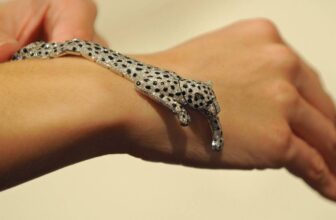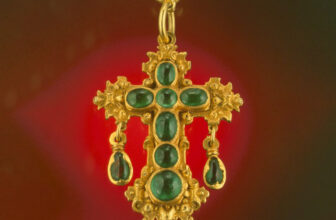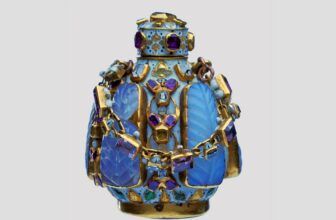
The Vladimir Tiara: A Jewel of Intrigue, Legacy, and Majesty
Few jewels in the world hold as much mystery, glamour, and layered history as the Vladimir Tiara. With its glittering diamonds, interchangeable pearls and emeralds, and storied past of escape, inheritance, and reinvention, the tiara represents not only exquisite craftsmanship but also the resilience of monarchy across turbulent centuries. Today, it is among the most iconic pieces in the British royal jewelry collection, frequently associated with Queen Elizabeth II, who wore it with effortless elegance. But behind the dazzle lies a story of revolution, smuggling, restoration, and legacy that makes the Vladimir Tiara one of the most fascinating jewels in the world.
This is the story of the Vladimir Tiara, the masterpiece that links imperial Russia with Britain’s modern monarchy.
What is the Vladimir Tiara?
The Vladimir Tiara is a stunning piece of jewelry that combines regal grandeur with remarkable versatility. Crafted in the late 19th century, the tiara is designed in a flexible looped pattern: fifteen interlinked diamond-set arches, each suspended with a hanging pendant. The pendants are interchangeable, allowing either natural drop-shaped pearls or vivid emerald drops to dangle elegantly from each loop.
When worn with pearls, the tiara exudes classic, understated refinement. With emeralds, it transforms into a bold, vibrant statement piece that draws the eye instantly. The ability to switch between pearls and emeralds gives the tiara an almost magical dual identity, able to shift between moods, occasions, and royal wardrobes. Sometimes, it has even been worn without any pendants at all, leaving only the brilliant diamond arches to sparkle on their own.
Its versatility is one of the reasons it has remained a favorite among queens and one of the most treasured items in the royal jewelry vaults.
How Much is the Vladimir Tiara Worth?
Putting a price on a tiara with such historical weight is nearly impossible, because its value lies as much in its legacy as in its gemstones. But we can estimate.
From a purely material perspective, the Vladimir Tiara features dozens of large, high-quality diamonds, natural saltwater pearls, and rare Colombian emeralds. A tiara of this scale and composition could easily reach tens of millions of pounds at auction. Experts often place its estimated worth between £15 million and £20 million, though some argue that, given its historical associations, it could fetch far more if it were ever to leave the royal collection.
But of course, the Vladimir Tiara’s real worth is immeasurable, it is a crown jewel, not a commodity. Its connection to imperial Russia, its journey through the upheavals of history, and its role as a symbol of continuity in the British monarchy elevate it beyond monetary value. In truth, the Vladimir Tiara is priceless.
The Origins: Grand Duchess Vladimir of Russia
The Vladimir Tiara was originally created for Grand Duchess Maria Pavlovna of Russia, known as Grand Duchess Vladimir. Born Duchess Marie of Mecklenburg-Schwerin, she married into the Russian imperial family in 1874, becoming the wife of Grand Duke Vladimir Alexandrovich, the son of Tsar Alexander II.
Grand Duchess Vladimir was a woman of immense glamour, charm, and social power. Known for hosting glittering balls in St. Petersburg, she was one of the most fashionable figures of the Russian court. To reflect her status, she commissioned a diamond and pearl tiara from the jeweler Bolin, the court jeweler to the Romanovs.
Completed around 1874, the tiara perfectly matched her taste: elegant yet dramatic, sophisticated yet flexible. She wore it often, and it became one of her most recognizable adornments.
Revolution and Escape: Smuggling the Tiara Out of Russia
The Russian Revolution of 1917 changed everything. The Romanovs were overthrown, and members of the imperial family faced exile, imprisonment, and in many cases, death. Grand Duchess Vladimir was forced to flee her palace in St. Petersburg.
She managed to escape to the Caucasus mountains, but her jewelry collection, including the Vladimir Tiara, was left behind, hidden inside her palace. Remarkably, her friend and British diplomat Albert Stopford risked his life to recover her treasures. Disguised and moving through revolutionary Russia, he smuggled the tiara and other jewels out of St. Petersburg in 1918, hiding them in a diplomatic bag.
From there, the jewels were transported to London, where they were reunited with Grand Duchess Vladimir in exile. It was an extraordinary escape story, one that gave the Vladimir Tiara an aura of drama and survival that few other jewels possess.
How Did Queen Mary Get the Vladimir Tiara?
After the death of Grand Duchess Vladimir in 1920, her jewels were inherited by her children. But her family, now living in exile, faced financial strain. To settle debts and adapt to their new circumstances, many of her jewels were put up for sale.
It was here that the Vladimir Tiara found its new royal owner: Queen Mary of the United Kingdom, grandmother of Queen Elizabeth II.
Queen Mary, wife of King George V, was famously passionate about jewelry. She collected and commissioned some of the most exquisite pieces in the royal collection, often acquiring historical jewels from other European royal families who had fallen on hard times. In 1921, Queen Mary purchased the Vladimir Tiara from the Vladimir family.
But she did not stop there. Always inventive, Queen Mary decided to adapt the tiara further. She commissioned the royal jeweler Garrard to create the interchangeable emerald drops, sourced from the famous Cambridge emeralds. These emeralds had been won decades earlier in a charity lottery by her grandmother, the Duchess of Cambridge. Now, they were repurposed into one of the most dazzling tiaras in the royal collection.
Through Queen Mary’s vision, the Vladimir Tiara gained its dual identity: pearls for tradition, emeralds for drama.
Queen Elizabeth II and the Vladimir Tiara
Upon Queen Mary’s death in 1953, her granddaughter, Queen Elizabeth II, inherited the Vladimir Tiara. It quickly became one of her favorites, not only because of its elegance but also because of its adaptability.
Over her long reign, Queen Elizabeth II wore the Vladimir Tiara on numerous state occasions, both with pearls and emeralds. Photographs of her wearing the emerald version are especially iconic, the vivid green stones contrasting beautifully with her white gowns and silver hair.
The tiara became so closely associated with her that many people consider it “hers,” even though it belongs to the royal collection, not her personally.
Who Has the Vladimir Tiara Now?
With Queen Elizabeth II’s passing in 2022, the Vladimir Tiara became part of the royal jewelry collection inherited by her son, King Charles III. Like most historic jewels, it remains part of the Crown’s collection of personal jewels, which pass from monarch to monarch rather than being privately sold or divided.
At present, the tiara has not yet been worn publicly by Queen Camilla, though she may choose to in the future. Alternatively, it may be reserved for other senior royal women, such as the Princess of Wales, Catherine. Time will reveal who carries forward the legacy of the Vladimir Tiara, but its place in the royal vaults is secure.
The Allure of the Vladimir Tiara
Why does this tiara continue to fascinate the world?
Partly, it is the sheer artistry. The balance of diamonds, the elegant loops, the dangling pendants, all combine to create a piece of jewelry that is timeless yet distinctive.
But beyond its beauty, the tiara carries stories:
A glamorous Russian duchess who dazzled at imperial balls.
A daring escape through revolution and smuggling.
A queen who reinvented it with emeralds from her family lottery.
A modern monarch who wore it as a symbol of dignity and continuity.
Each chapter adds depth to its sparkle, making it not just a jewel, but a storyteller in itself.
The Vladimir Tiara in Popular Imagination
Over the years, the Vladimir Tiara has become a favorite subject of royal watchers, jewel historians, and fashion enthusiasts. It often features in exhibitions, books, and documentaries about the royal collection. When displayed, it invariably draws crowds, who marvel at its dazzling adaptability.
It also represents the enduring fascination with tiaras themselves. In the modern world, where tiaras are rarely worn outside royal circles, they evoke a sense of old-world romance and grandeur. And among all royal tiaras, the Vladimir is one of the most instantly recognizable.
A Jewel Beyond Time
The Vladimir Tiara is more than diamonds, pearls, and emeralds, it is a thread that connects imperial Russia to modern Britain, a survivor of revolution, a creation of artistry, and a symbol of royal identity.
From the grand salons of St. Petersburg to the glittering banquets of Buckingham Palace, it has shone across centuries, embodying the drama of history and the timeless power of beauty.
Today, it rests safely in the royal collection, awaiting its next wearer, perhaps to dazzle at future coronations, state dinners, or jubilees. Whatever comes, the Vladimir Tiara will remain one of the crown jewels not just of Britain, but of storytelling itself.




